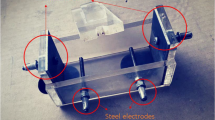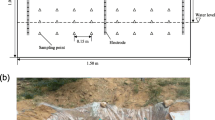Abstract
Rapid detection of oil released from underground storage tanks and estimation of its flow rate allows for the prevention of further contamination or the limitation of the spread of contaminants. In this research, we developed a method for oil release detection by sensing volumetric water contents (VWC) in a hydraulic control system. Oil release detection tests were conducted at bench and pilot scales. In the bench-scale test, oil and water were released directly on top of the oil release detection system. In the pilot-scale test, the release detection system was installed in the soil and the oil was spilled on the soil surface. The new oil release monitoring system was capable of detecting the oil release using the VWC decrease (0.42 → 0.11 m3/m3). The infiltration of water did not affect the value of VWC. Sequential injection or mixture of oil and water also showed a decrease in VWC (0.42 → 0.12 m3/m3). The rate of VWC decrease was directly proportional (− 0.003 ml/min) to the rate of oil infiltration. A conceptual model was suggested to delineate the mechanism of oil release detection and to estimate the rate of oil infiltration. The detectability of the oil release in soil was also verified in the pilot-scale test (0.45 → 0.12 m3/m3). The rate of oil infiltration could be estimated using the slope of the measured VWC. The amount of time for oil infiltration through the soil and dispersion during the migration should be considered to analyze the VWC curve properly. These results showed that the oil release detection system can be used to monitor oil release and to determine the rate of oil infiltration by installation in the soil near an underground storage tank.








Similar content being viewed by others
References
EPA, U.: 2016, Release detection for underground storage tanks and piping: straight talk on tanks, Report No. EPA 510-K-16-003.
EPA, U.: 2017a, How to evaluate alternative cleanup technologies for underground storage tank sites: a guide for corrective action plan reviewers, Report No. EPA/510/B-17-003, office of underground storage tanks, US EPA, Washington Google Scholar.
EPA, U.: 2017b, Release detection for underground storage tanks (USTs).
Farhadian, M., Vachelard, C., Duchez, D., & Larroche, C. (2008). In situ bioremediation of monoaromatic pollutants in groundwater: a review. Bioresource Technology, 99, 5296–5308.
Francisca, F. M., & Montoro, M. A. (2012). Measuring the dielectric properties of soil-organic mixtures using coaxial impedance dielectric reflectometry. Journal of Applied Geophysics, 80, 101–109.
Gasch, C. K., Brown, D. J., Campbell, C. S., Cobos, D. R., Brooks, E. S., Chahal, M., & Poggio, M. (2017). A field-scale sensor network data set for monitoring and modeling the spatial and temporal variation of soil water content in a dryland agricultural field. Water Resources Research, 53, 10878–10887.
Gorawski, M., Gorawska, A., & Pasterak, K. (2017). The TUBE algorithm: discovering trends in time series for the early detection of fuel leaks from underground storage tanks. Expert Systems with Applications, 90, 356–373.
Ho, C. K., & Hughes, R. C. (2002). In-situ chemiresistor sensor package for real-time detection of volatile organic compounds in soil and groundwater. Sensors, 2, 23–34.
Kargas, G., & Kerkides, P. (2012). Comparison of two models in predicting pore water electrical conductivity in different porous media. Geoderma, 189, 563–573.
Lieberman, S. H. (1998). Direct-push, fluorescence-based sensor systems for in situ measurement of petroleum hydrocarbons in soils. Field Analytical Chemistry and Technology, 2, 63–73.
Liu, F. F., Peng, C., & Ng, J. C. (2015a). BTEX in vitro exposure tool using human lung cells: trips and gains. Chemosphere, 128, 321–326.
Liu, Z. B., Liu, S. Y., Cai, Y., & Fang, W. (2015b). Electrical resistivity characteristics of diesel oil-contaminated kaolin clay and a resistivity-based detection method. Environmental Science and Pollution Research, 22, 8216–8223.
Morisawa, M. & Muto, S.: 2012, Plastic optical fibre sensing of fuel leakage in soil. Journal of Sensors.
Nadim, F., Hoag, G. E., Liu, S. L., Carley, R. J., & Zack, P. (2000). Detection and remediation of soil and aquifer systems contaminated with petroleum products: an overview. Journal of Petroleum Science and Engineering, 26, 169–178.
Oh, M., Seo, M. W., Lee, S., & Park, J. (2008). Applicability of grid-net detection system for landfill leachate and diesel fuel release in the subsurface. Journal of Contaminant Hydrology, 96, 69–82.
Ritchie, L., Ferguson, C., & Saini, S. (2000a). A novel sensor for monitoring leakage of petroleum and other liquid hydrocarbons into soil environments. Journal of Environmental Monitoring, 2, 193–196.
Ritchie, L. J., Ferguson, C. P., Bessant, C., & Saini, S. (2000b). A ten channel fibre-optic device for distributed sensing of underground hydrocarbon leakage. Journal of Environmental Monitoring, 2, 670–673.
Rosenbaum, U., Huisman, J. A., Weuthen, A., Vereecken, H., & Bogena, H. R. (2010). Sensor-to-sensor variability of the ECH2O EC-5, TE, and 5TE sensors in dielectric liquids. Vadose Zone Journal, 9, 181–186.
Saeed, T., & Al-Mutairi, M. (1999). Chemical composition of the water-soluble fraction of the leaded gasolines in seawater. Environment International, 25, 117–129.
Scudiero, E., Berti, A., Teatini, P., & Morari, F. (2012). Simultaneous monitoring of soil water content and salinity with a low-cost capacitance-resistance probe. Sensors, 12, 17588–17607.
Speir, R. A.: 2009. 'Petroleum storage and handling.
Teng, Y. G., Feng, D., Song, L. T., Wang, J. S., & Li, J. (2013). Total petroleum hydrocarbon distribution in soils and groundwater in Songyuan oilfield, Northeast China. Environmental Monitoring and Assessment, 185, 9559–9569.
Topp, G. C., Davis, J., & Annan, A. P. (1980). Electromagnetic determination of soil water content: Measurements in coaxial transmission lines. Water Resources Research, 16, 574–582.
Varble, J. L., & Chavez, J. L. (2011). Performance evaluation and calibration of soil water content and potential sensors for agricultural soils in eastern Colorado. Agricultural Water Management, 101, 93–106.
Vaz, C. M. P., Jones, S., Meding, M., & Tuller, M. (2013). Evaluation of standard calibration functions for eight electromagnetic soil moisture sensors. Vadose Zone Journal, 12.
Xie, G. B., & Barcelona, M. J. (2001). Efficient quantification of total petroleum hydrocarbons and applications at two contaminated sites. Ground Water Monitoring and Remediation, 21, 64–70.
Yin, M., Tang, S. F., & Tong, M. M. (2016). The application of terahertz spectroscopy to liquid petrochemicals detection: a review. Applied Spectroscopy Reviews, 51, 379–396.
Zhan, L. T., Mu, Q. Y., Chen, Y. M., & Chen, R. P. (2013). Experimental study on applicability of using time-domain reflectometry to detect NAPLs contaminated sands. Science China Technological Sciences, 56, 1534–1543.
Funding
This work was supported by the Korea Ministry of Environment as a “GAIA (Geo-Advanced Innovative Action) Project” (ARQ201502032003) and by National Research Foundation of Korea (NRF-2017R1C1B3009500).
Author information
Authors and Affiliations
Corresponding authors
Ethics declarations
Conflict of Interest
The authors declare that they have no conflict of interest.
Additional information
Publisher’s Note
Springer Nature remains neutral with regard to jurisdictional claims in published maps and institutional affiliations.
Rights and permissions
About this article
Cite this article
Lee, SG., Kim, BJ., Choi, JW. et al. Detection of Oil Release in Unsaturated Soil and Estimation of Oil Infiltration Rate Using Hydraulic Control System and Water Content Sensor. Water Air Soil Pollut 230, 92 (2019). https://doi.org/10.1007/s11270-019-4147-4
Received:
Accepted:
Published:
DOI: https://doi.org/10.1007/s11270-019-4147-4




